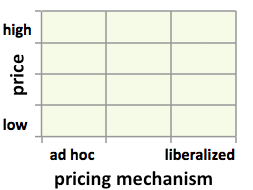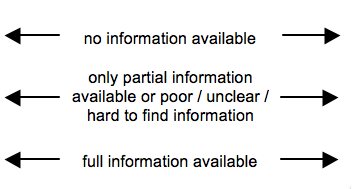Knowledge fuels change
For over a decade, Energypedia has shared free, reliable energy expertise with the world.
We’re now facing a serious funding gap.
Help keep this platform alive — your donation, big or small, truly matters!
Thank you for your support
Difference between revisions of "Fuel Prices Syria"
***** (***** | *****) m (Protected "Fuel Prices Syria" ([edit=sysop] (indefinite) [move=sysop] (indefinite)) [cascading]) |
***** (***** | *****) m |
||
| (4 intermediate revisions by one other user not shown) | |||
| Line 1: | Line 1: | ||
{{Fuel Price Factsheet | {{Fuel Price Factsheet | ||
|Fuel Price Country=Syria | |Fuel Price Country=Syria | ||
| + | |Fuel Pricing Policies=“Pricing policy: Government controls, subsidizes, and infrequently adjusts fuel. Most gasoline is 90 RON, the price of which was raised to S£44 (US$0.93)/liter in Sep 2010, and raised again in Dec 2011. In Nov 2010, government said it would allow imports of 95 RON gasoline, to be sold at S£50 (US$1.08)/liter. In 2010, government had put forward 2015 as the year in which to move to market pricing. The diesel price was raised in Apr 2008 from S£7 (US$0.15) to S£25 (US$0.52), but cut to S£20 (US$0.43) in Apr 2009 and further to S£15 (US$0.32) in May 2011 before being raised to S£20 (US0.32) in May 2012. Government raised the gasoline price in Sep 2010 and Dec 2011. In Nov 2010, government said it would allow imports of 95 RON gasoline, to be sold at S£50 (US$1.08)/liter. Most gasoline is 90 RON, the price of which was raised to S£44 (US$0.93)/liter in Sep 2010. In 2010, government had put forward 2015 as the year in which to move to market pricing. | ||
| + | |||
| + | Consequences of subsidies: Mahrukat, Syria’s sole buyer and distributor, reported losses totaling S£372 billion (US$7.9 billion) in 2008, falling dramatically to S£14 billion (US$0.3 billion) in 2009 due to lower world prices and higher domestic prices. Subsidy in 2010 was reported to have topped US$2.9 billion. In May 2012, when the diesel price was raised to S£20/liter, government said the subsidies had exceeded S£250 billion (US$4 billion). | ||
| + | |||
| + | Social protection: Every household received a coupon to buy 1,000 liters of diesel at S£9 (US$0.19)/liter when government nearly tripled the diesel price in Apr 2008. Government in Jan 2011 increased the heating oil allowance for two million public workers and retirees by 72 percent to about 1,500 Syrian pounds (US$32) a month.” | ||
| + | |||
| + | (Source: Kojima, Masami. (2013, forthcoming). “Petroleum product pricing and complementary policies:Experience of 65 developing countries since 2009.” Washington DC: World Bank.) | ||
|Fuel Currency=SYP | |Fuel Currency=SYP | ||
|Fuel Price Exchange Rate=45.779 | |Fuel Price Exchange Rate=45.779 | ||
| − | |||
| − | |||
| − | |||
|Fuel Price Composition Annotation=No information available. | |Fuel Price Composition Annotation=No information available. | ||
| − | |Fuel Pricing | + | |Fuel Matrix Pricing Mechanism=1 |
| − | |||
| − | |||
| − | |||
| − | |||
|Fuel Matrix Price Level=2 | |Fuel Matrix Price Level=2 | ||
| − | |||
|Fuel Matrix Annotation=No accessible public information available on the price composition and pricing mechanism. | |Fuel Matrix Annotation=No accessible public information available on the price composition and pricing mechanism. | ||
|Fuel Transparency Price Composition=1 | |Fuel Transparency Price Composition=1 | ||
|Fuel Transparency Pricing Mechanism=1 | |Fuel Transparency Pricing Mechanism=1 | ||
}} | }} | ||
| + | |||
| + | [[Category:Syria]] | ||
Latest revision as of 13:12, 23 September 2014
Part of: GIZ International Fuel Price database
Also see: Syria Energy Situation
Fuel Pricing Policies
| Local Currency: | SYP |
| Exchange Rate: | 45.779
|
| Last Update: |
“Pricing policy: Government controls, subsidizes, and infrequently adjusts fuel. Most gasoline is 90 RON, the price of which was raised to S£44 (US$0.93)/liter in Sep 2010, and raised again in Dec 2011. In Nov 2010, government said it would allow imports of 95 RON gasoline, to be sold at S£50 (US$1.08)/liter. In 2010, government had put forward 2015 as the year in which to move to market pricing. The diesel price was raised in Apr 2008 from S£7 (US$0.15) to S£25 (US$0.52), but cut to S£20 (US$0.43) in Apr 2009 and further to S£15 (US$0.32) in May 2011 before being raised to S£20 (US0.32) in May 2012. Government raised the gasoline price in Sep 2010 and Dec 2011. In Nov 2010, government said it would allow imports of 95 RON gasoline, to be sold at S£50 (US$1.08)/liter. Most gasoline is 90 RON, the price of which was raised to S£44 (US$0.93)/liter in Sep 2010. In 2010, government had put forward 2015 as the year in which to move to market pricing.
Consequences of subsidies: Mahrukat, Syria’s sole buyer and distributor, reported losses totaling S£372 billion (US$7.9 billion) in 2008, falling dramatically to S£14 billion (US$0.3 billion) in 2009 due to lower world prices and higher domestic prices. Subsidy in 2010 was reported to have topped US$2.9 billion. In May 2012, when the diesel price was raised to S£20/liter, government said the subsidies had exceeded S£250 billion (US$4 billion).
Social protection: Every household received a coupon to buy 1,000 liters of diesel at S£9 (US$0.19)/liter when government nearly tripled the diesel price in Apr 2008. Government in Jan 2011 increased the heating oil allowance for two million public workers and retirees by 72 percent to about 1,500 Syrian pounds (US$32) a month.”
(Source: Kojima, Masami. (2013, forthcoming). “Petroleum product pricing and complementary policies:Experience of 65 developing countries since 2009.” Washington DC: World Bank.)
Fuel Prices and Trends
| Gasoline 95 Octane | Diesel | |
|---|---|---|
| in USD* |
|
|
| in Local Currency |
|
|
* benchmark lines: green=US price; grey=price in Spain; red=price of Crude Oil
Fuel Price Composition
Price composition.
No information available.
At a Glance
| Regulation-Price-Matrix |
| ||||
 |

|

|

| ||
No accessible public information available on the price composition and pricing mechanism.
Sources to the Public
Contact
Please find more information on GIZ International Fuel Price Database and http://www.giz.de/fuelprices



















